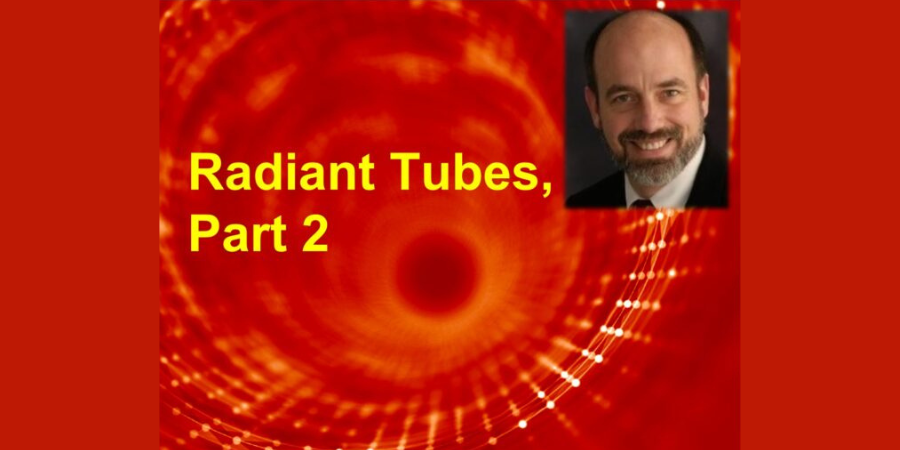 Last month, we introduced the importance of radiant tubes in the heat treat industry. We explored the “why” of radiant tubes and skimmed the surface, exploring materials, sizing, shapes, longevity, and installation — all topics we’ll deep dive into in future posts. This month, let’s explore what typically occurs inside a radiant tube.
Last month, we introduced the importance of radiant tubes in the heat treat industry. We explored the “why” of radiant tubes and skimmed the surface, exploring materials, sizing, shapes, longevity, and installation — all topics we’ll deep dive into in future posts. This month, let’s explore what typically occurs inside a radiant tube.
This column is a Combustion Corner feature written by John Clarke, technical director at Helios Electric Corporation, and appeared in Heat Treat Today's December 2022 Medical and Energy print edition.
If you have suggestions for topics you’d like John to explore in future columns, please email Karen@heattreattoday.com.

Technical Director
Helios Electric Corporation
Source: Helios Electrical Corporation
The radiant tube burner combines fuel and an oxidizer (commonly air) in the presence of a source of ignition. Radiant tube burners differ from burners that are fired into an open furnace. They function to distribute heat as uniformly as possible within the interior of the tube to maximize its temperature and heat transfer uniformity. In some applications, a low rate of heat transfer is acceptable (for example, in the holding zone of a continuous furnace). In that same furnace, a much higher heat transfer rate may be required in the front of the furnace. In all cases, higher heat transfer rates result in higher internal tube temperatures. In most cases, the higher the temperature, the greater the stress on the material.
Within the radiant tube in the visual flame region, the energy is transferred to the inner surface of the tube by convection and radiation. The rate of convective transfer has much to do with the mixing characteristics of the burner in question. Once combustion is complete, the heated products of combustion — CO2 , O2 , H2O, and N2 — continue to flow through the radiant tube. They impart heat to the interior surface of the radiant tube through convections and — in the case of the CO2 and H2 — radiation. The non-polar gases (O2 and N2) are effectively transparent to radiation: neither absorbing nor radiating heat. This transparency poses a problem for the performance of radiant tubes because the combustion process is ideally complete some distance before the end of the radiant tube.
There are a few ways to make use of the heat stored in the O2 and N2 . One way is to stir the mixtures to ensure these gases meet the inside walls of the tube and can convectively transfer their energy. Another way is to insert a “core buster” or other device into the exit end of the radiant tube. This device must be able to withstand the peak temperature of the products of combustion at this point, so it is typically constructed of some ceramic material or a composite of ceramics. As the heated gases pass over this “core buster,” the resistance forces higher flows around the perimeter of the tube, increasing convective transfer. The “core buster” also is convectively heated and can then radiate heat to the inner surface of the tube and, finally, the “core buster” increases mixing of the gases to ensure all remaining hydrocarbons and carbon monoxide are brought into contact with oxygen to complete the oxidation process.
The transfer of heat to the inner surface is dependent on the effective surface area. A tube with a nominal inside diameter of four inches may have a much greater effective surface area due to roughness, which resemble very small peaks and valleys. Anyone who has attempted to walk around a small Caribbean island can attest — it takes a lot longer than you would think by looking at the map and really scares your shipmates when they cannot find you. Cast and composite radiant tubes can be fabricated to increase this effective internal surface area. Tubing can also be equipped with internal fins.[blocktext align="left"]No matter what the construction, ultimately it does no good to transfer heat to the interior of the radiant tube if the tube cannot transfer the same quantity of heat through the exterior to the furnace and work being heated.[/blocktext]
Which mode of control is better? High/Low, proportional, or pulsed? Any method can achieve a uniform tube heat release given the correct burner radiant tube combination. The important thing is that the vigor of the mixing is matched to the length and roughness of the radiant tube. Burner X may be perfectly suited to a short radiant tube but lead to non-uniform heating as the tube length is extended. On the other hand, Burner Y, with a relatively lazy flame, may work perfectly on long tubes with lower heat transfer demands but be unsuitable for short tubes where high heat transfer rates are desired.
In the coming months, we will examine many of these areas in greater detail, and this author can make use of his experience of many failures to inform the readers of what not to do. Then, by extension, we’ll learn how to get more from the furnaces by thinking systematically about their radiant tubes, burners, and controls.
 Find heat treating products and services when you search on Heat Treat Buyers Guide.com
Find heat treating products and services when you search on Heat Treat Buyers Guide.com






